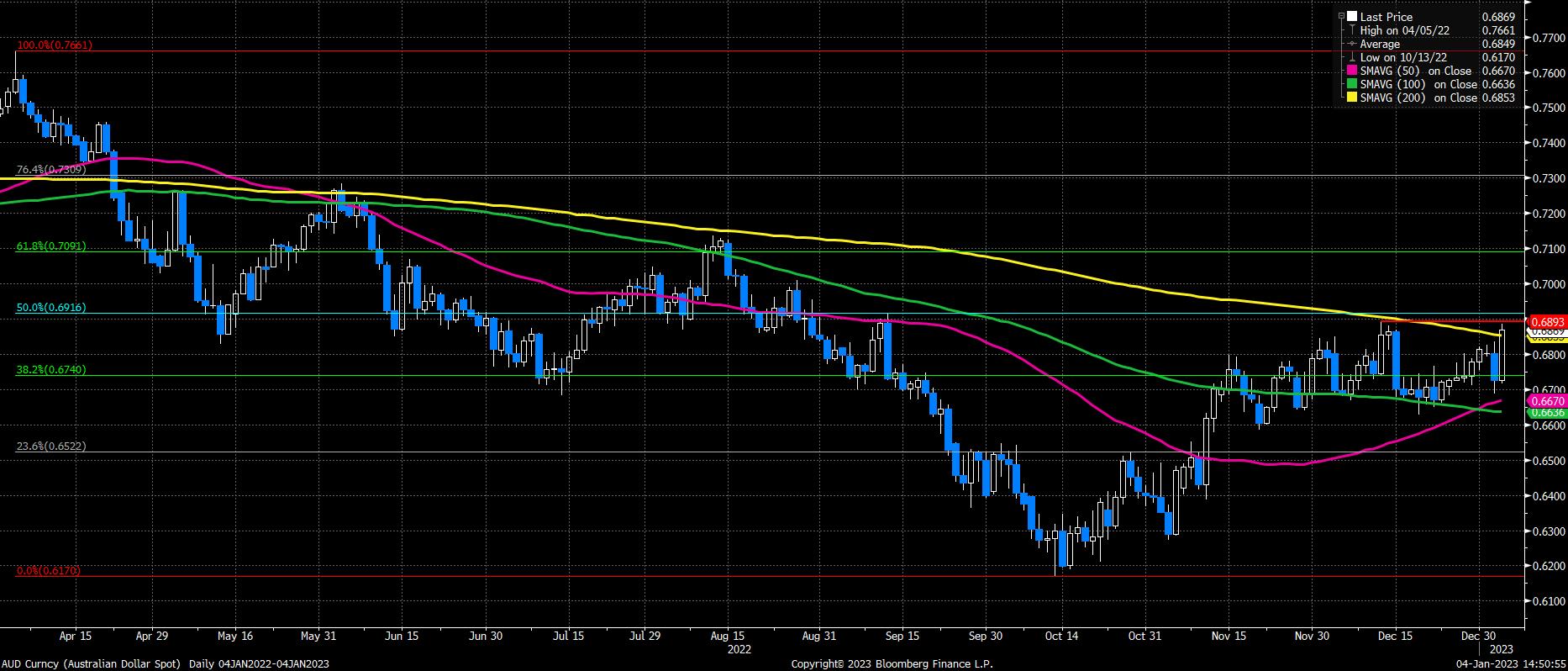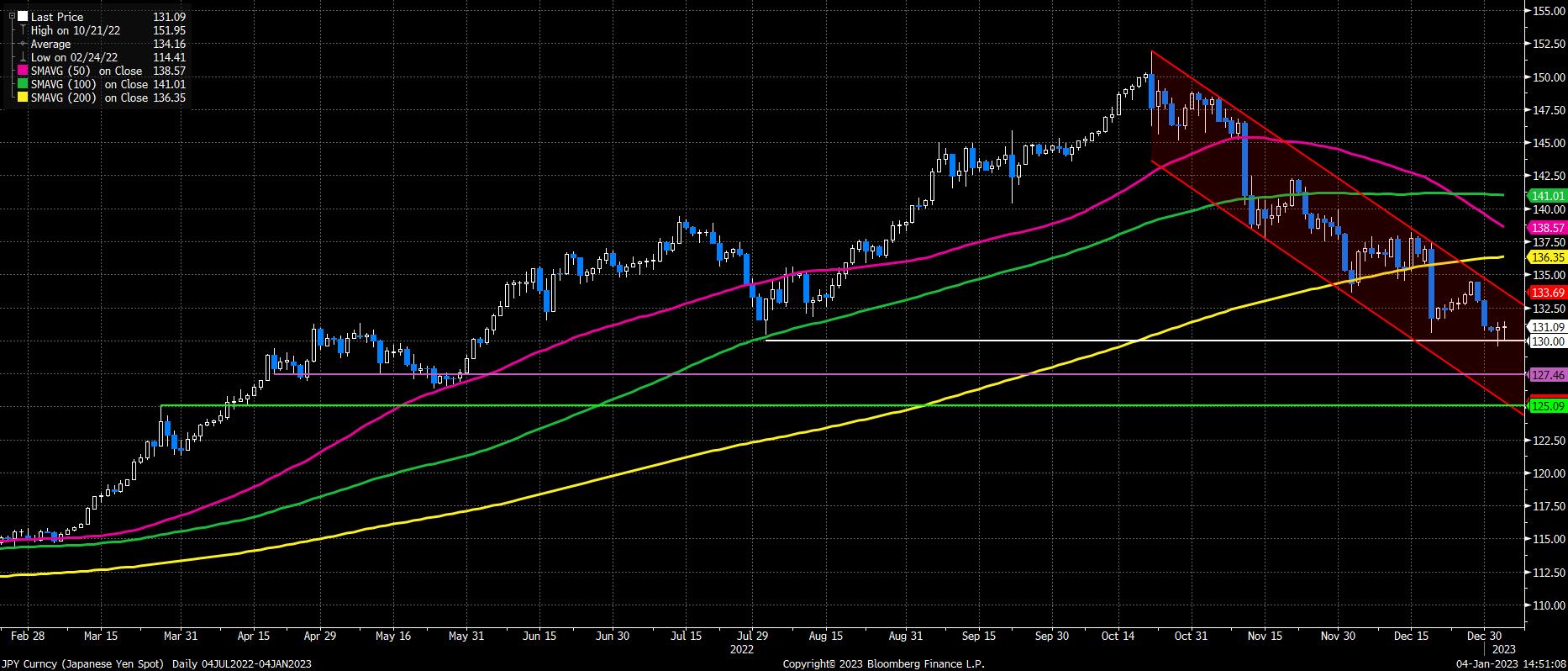- English (UK)
A Busy Start To The New Year
Consensus is very clear heading into 2023 – slowing growth, with both the eurozone and UK already in recession; easing inflation, albeit not enough to see central banks ease off the economic brake pedal; China re-opening, in bumpy fashion; and, last but not least, sizeable geopolitical risk persisting throughout the coming 12 months.
That said, there are tentative signs that some geopolitical tensions may be easing. Reports that China, after a couple of years, are set to consider easing a ban on Australian coal imports have seen the bulls pile into the AUD, while also helping to give the Kiwi and other high-beta G10s a lift in the process.
The move, a chunky gain of over 2%, has taken AUD/USD north of the 200-day moving average for the first time in 10 months, with the 50% retracement of last year’s decline at 0.6915 now starting to come into view.

Such a sharp rally on a relatively vague headline does, however, further support the idea that markets haven’t quite got ‘up and running’ for the new year just yet – volumes, broadly speaking, are still a little on the light side.
It will likely be this Friday’s US labour market report that sees markets kick into top gear once again, with traders watching closely for any signs that the Fed’s aggressive tightening – 425bps worth in 2022 – is starting to detrimentally impact an employment market which to date has proved surprisingly resilient.
Consensus expects nonfarm payrolls to have risen by +200k in December, with unemployment set to hold steady at 3.7%, and earnings expected to have risen by 0.4% MoM, a pace incompatible with a rapid return to the Fed’s 2% price target. The balance of risks seems tilted towards a bigger market reaction on a data miss than a beat, given that a stellar report is unlikely to stop the Fed from a further downshift in the pace of hikes to a 25bps at the February meeting.
In contrast, softer than expected figures are likely to prove another case of bad economic news being good news for risk, leading markets to price in both a sooner end to the tightening cycle, and a greater degree of easing in the second half of the year. The S&P is rather delicately poised heading into the jobs report, remaining trapped between support around 3800, with gains continuing to be capped by both the 50- and 100-day moving averages to the upside.

While payrolls will be in the spotlight this week, it is the latest US CPI report next Thursday which is likely to prove a more significant event – both in terms of market movement, and impact on the policy outlook. After declining for 5 consecutive months, with the prior two prints both being substantially cooler than expected, and with energy prices having continued to decline, market expectations are significant for a further drop in the inflation rate this time around.
As with 2022, US CPI prints are set to remain the marquee event risks facing markets for now, particularly with the Fed remaining squarely focused on the inflation side of the dual mandate – a quicker than expected cooling of price pressures could see the FOMC dial back some of the hawkish rhetoric in relatively short order, another bullish catalyst for both equities and bonds, as well as another headwind for the dollar.
USD/JPY looks to be one of the most favoured ways to play a USD bearish theme during the year ahead, particularly given significant expectations that Kuroda’s departure in April will spark a hawkish pivot from the Bank of Japan. While the JPY has rallied sharply over the last 6 weeks, a break of the 130 handle could see the move gather renewed momentum.

Related articles
The material provided here has not been prepared in accordance with legal requirements designed to promote the independence of investment research and as such is considered to be a marketing communication. Whilst it is not subject to any prohibition on dealing ahead of the dissemination of investment research we will not seek to take any advantage before providing it to our clients.
Pepperstone doesn’t represent that the material provided here is accurate, current or complete, and therefore shouldn’t be relied upon as such. The information, whether from a third party or not, isn’t to be considered as a recommendation; or an offer to buy or sell; or the solicitation of an offer to buy or sell any security, financial product or instrument; or to participate in any particular trading strategy. It does not take into account readers’ financial situation or investment objectives. We advise any readers of this content to seek their own advice. Without the approval of Pepperstone, reproduction or redistribution of this information isn’t permitted.
